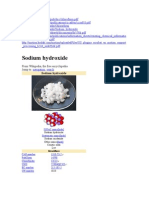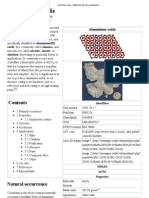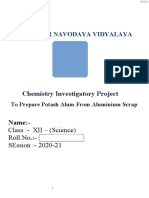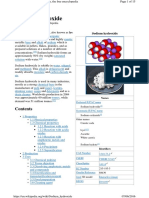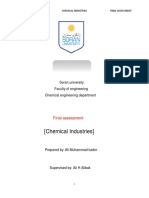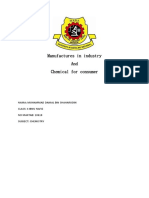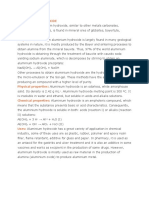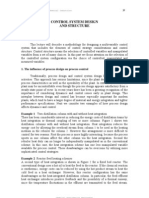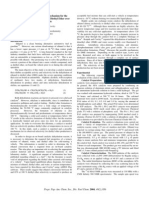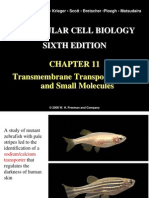Sodium Aluminate
Sodium Aluminate
Uploaded by
lumengentiunCopyright:
Available Formats
Sodium Aluminate
Sodium Aluminate
Uploaded by
lumengentiunCopyright
Available Formats
Share this document
Did you find this document useful?
Is this content inappropriate?
Copyright:
Available Formats
Sodium Aluminate
Sodium Aluminate
Uploaded by
lumengentiunCopyright:
Available Formats
Sodium aluminate
1
Sodium aluminate
Sodium aluminate
Identifiers
CAS number
1302-42-7
[1]
PubChem
14766
[2]
Jmol-3D images
Image 1
[3]
Properties
Molecular formula NaAlO
2
Molar mass 81.97 g/mol
Appearance white powder (sometimes light-yellowish)
Density
1.5 g/cm
3
Melting point 1650 C
Solubility in water soluble
Solubility in Alcohol soluble
Refractive index (n
D
) 1.58
Except where noted otherwise, data are given for materials in their standard state (at 25C (77F), 100kPa)
(verify)
[4]
(what is: / ?)
Infoboxreferences
Sodium aluminate is an important commercial inorganic chemical. It works as an effective source of aluminium
hydroxide for many industrial and technical applications. Pure sodium aluminate (anhydrous) is a white crystalline
solid having a formula variously given as NaAlO
2
, NaAl(OH)
4
(hydrated), Na
2
OAl
2
O
3
, or Na
2
Al
2
O
4
. Commercial
sodium aluminate is available as a solution or a solid.
Other related compounds, sometimes called sodium aluminate, prepared by reaction of Na
2
O and Al
2
O
3
are
Na
5
AlO
4
which contains discrete AlO
4
5
anions, Na
7
Al
3
O
8
and Na
17
Al
5
O
16
which contain complex polymeric
anions, and NaAl
11
O
17
, once mistakenly believed to be -alumina, a phase of aluminium oxide.
[5][6]
Structure
Anhydrous sodium aluminate, NaAlO
2
, contains a three-dimensional framework of corner linked AlO
4
tetrahedra.
The hydrated form NaAlO
2
5/4H
2
O has layers of AlO
4
tetrahedra joined into rings and the layers are held together
by sodium ions and water molecules that hydrogen bond to O atoms in the AlO
4
tetrahedra.
[7]
Manufacturing
Sodium aluminate is manufactured by the dissolution of- aluminium hydroxide in a caustic soda (NaOH) solution.
Aluminium hydroxide (gibbsite) can be dissolved in 2025% aqueous NaOH solution at a temperature near the
boiling point. The use of more concentrated NaOH solutions leads to a semi-solid product. The process must be
carried out in steam-heated vessels of nickel or steel, and the aluminium hydroxide should be boiled with
approximately 50% aqueous caustic soda until a pulp forms. The final mixture has to be poured into a tank and
Sodium aluminate
2
cooled; a solid mass containing about 70% NaAlO
2
then forms. After being crushed, this product is dehydrated in a
rotary oven heated either directly or indirectly by burning hydrogen. The resulting product contains 90% NaAlO
2
and 1% water, together with 1% free NaOH.
Reaction of aluminium metal and alkali
Sodium aluminate is also formed by the action of sodium hydroxide on elemental aluminium which is an amphoteric
metal. The reaction is highly exothermic once established and is accompanied by the rapid evolution of hydrogen
gas. The reaction is sometimes written as:
2 Al + 2 NaOH + 2 H
2
O 2 NaAlO
2
+ 3 H
2
however the species produced in solution is likely to contain the [Al(OH)
4
]
ion or perhaps the [Al(H
2
O)
2
(OH)
4
]
.
This reaction has been proposed as a potential source of fuel for hydrogen powered cars.
Uses
In water treatment it is used as an adjunct to water softening systems, as a coagulant aid to improve flocculation, and
for removing dissolved silica and phosphates.
In construction technology, sodium aluminate is employed to accelerate the solidification of concrete, mainly when
working during frost.
Sodium aluminate is also used in the paper industry, for fire brick production, alumina production and so forth.
Sodium aluminate solutions are intermediates in the production of zeolites.
[8]
References
[1] http:/ / www. commonchemistry.org/ ChemicalDetail.aspx?ref=1302-42-7
[2] http:/ / pubchem. ncbi. nlm.nih. gov/ summary/ summary. cgi?cid=14766
[3] http:/ / chemapps.stolaf. edu/ jmol/ jmol.php?model=O%3D%5BAl-%5D%3DO. %5BNa%2B%5D
[4] http:/ / en. wikipedia. org/ w/ index. php?title=Special:ComparePages& rev1=414397248& page2=Sodium+ aluminate
[5] "Identification and characterisation of three novel compounds in the sodiumaluminiumoxygen system", Marten G. Barker, Paul G. Gadd
and Michael J. Begley, J. Chem. Soc., Dalton Trans., 1984, 11391146,
[6] Egon Wiberg, Arnold Frederick Holleman (2001) Inorganic Chemistry, Elsevier ISBN 0-12-352651-5
[7] "The Crystal Structure of Hydrated Sodium Aluminate, NaAlO
2
5/4H
2
O, and Its Dehydration Product", James A. Kaduk, Shiyou Pei, Journal
of Solid State Chemistry, 115, 1, 1995, 126139,
[8] Alan Dyer, (1994), Encyclopedia of Inorganic Chemistry, R. Bruce King (ed.), John Wiley & Sons, ISBN 0-471-93620-0
Article Sources and Contributors
3
Article Sources and Contributors
Sodium aluminate Source: http://en.wikipedia.org/w/index.php?oldid=607201552 Contributors: Anomalocaris, Axiosaurus, Bryan Derksen, David Berardan, Deryck Chan, Epbr123, Foobar,
Hermann Luyken, LievenBekaert, Magioladitis, Materialscientist, MiPe, Perfecto, PeterBFZ, Physchim62, Stan J Klimas, Thricecube, Velella, Wavelength, Woodyim9691, Xezbeth, Yakuzai, 17
anonymous edits
Image Sources, Licenses and Contributors
File:Yes check.svg Source: http://en.wikipedia.org/w/index.php?title=File:Yes_check.svg License: Public Domain Contributors: Anomie
File:X mark.svg Source: http://en.wikipedia.org/w/index.php?title=File:X_mark.svg License: Public Domain Contributors: User:Gmaxwell
License
Creative Commons Attribution-Share Alike 3.0
//creativecommons.org/licenses/by-sa/3.0/
You might also like
- ASTM D 6940 - 03Document5 pagesASTM D 6940 - 03Jordan RiveraNo ratings yet
- Gas Lift PresentationDocument20 pagesGas Lift Presentationfadzil_rani100% (1)
- 1Document19 pages1Rayadi Sinaga100% (1)
- Sodium Hydroxide: 1 PropertiesDocument9 pagesSodium Hydroxide: 1 PropertiesApolloMPNo ratings yet
- Properties of Potash AlumDocument8 pagesProperties of Potash AlumAminu TeslimNo ratings yet
- Aluminium Oxide - Wikipedia, The Free EncyclopediaDocument7 pagesAluminium Oxide - Wikipedia, The Free Encyclopediad_richard_dNo ratings yet
- Aluminum Sulfate As A Water Purifier Coagulant by Ni Luh Putu Agustina Putri 1713081015Document8 pagesAluminum Sulfate As A Water Purifier Coagulant by Ni Luh Putu Agustina Putri 1713081015putrik agustinaNo ratings yet
- CHEMDocument14 pagesCHEMBimal KumariNo ratings yet
- To Prepare Potash Alum From Aluminium ScrapDocument16 pagesTo Prepare Potash Alum From Aluminium ScrapAkshayNo ratings yet
- Aluminium CompoundDocument17 pagesAluminium Compoundmouse1201100% (1)
- Reaction TypesDocument10 pagesReaction TypesaqibazizkhanNo ratings yet
- Aluminum Oxide From Bayer Process, Metallurgical GradeDocument28 pagesAluminum Oxide From Bayer Process, Metallurgical GradeSeyit AvcuNo ratings yet
- Chemistry Project Report Class 12 Cbse 2020 2021 Oon Topic Prepration of Potassh Alum From Alminium Scrap RemovedDocument10 pagesChemistry Project Report Class 12 Cbse 2020 2021 Oon Topic Prepration of Potassh Alum From Alminium Scrap Removedkai9princuNo ratings yet
- Specialty ChemicalsDocument30 pagesSpecialty ChemicalsucheNo ratings yet
- Preparation of Potash Alum From Scrap Aluminium.Document10 pagesPreparation of Potash Alum From Scrap Aluminium.RamashrayNo ratings yet
- Potash Alum Chemistry Invesigatory Project Class 12Document14 pagesPotash Alum Chemistry Invesigatory Project Class 12Niklesh SelvaNo ratings yet
- Dokumen - Tips - Chemistry Project On Preparation of Potash AlumDocument13 pagesDokumen - Tips - Chemistry Project On Preparation of Potash AlumSarvesh BoseNo ratings yet
- Methods of Production: Mercury Cell ProcessDocument11 pagesMethods of Production: Mercury Cell Processahyar47No ratings yet
- Shaurya Chem Project - Potash Alum From Scrap AluminiumDocument8 pagesShaurya Chem Project - Potash Alum From Scrap AluminiumShaurya KapoorNo ratings yet
- Synthesis of Common Alum: Chrome Alum KCR (So) - 12H ODocument11 pagesSynthesis of Common Alum: Chrome Alum KCR (So) - 12H OidaayudwitasariNo ratings yet
- Jasmitha Project 2Document10 pagesJasmitha Project 2muralidharangt7No ratings yet
- The Preparation of Common Alum From Scrap AluminiumDocument13 pagesThe Preparation of Common Alum From Scrap AluminiumJoe Calvin RossarioNo ratings yet
- A01 527 PDFDocument17 pagesA01 527 PDFjaimeNo ratings yet
- Sodium SilicateDocument12 pagesSodium Silicatemoses_cNo ratings yet
- Potashalum Chem ProjectDocument16 pagesPotashalum Chem ProjectJanani KaNo ratings yet
- Introduction class 12Document11 pagesIntroduction class 12singhrawatsujal56No ratings yet
- 2Document10 pages2soumya.sj09No ratings yet
- Wiki Sodium HydroxideDocument15 pagesWiki Sodium HydroxidesaiNo ratings yet
- Caustic Soda ProductionDocument21 pagesCaustic Soda ProductionLailaNo ratings yet
- CoagulantesDocument48 pagesCoagulantesAna MaríaNo ratings yet
- Recovery and Separation of Palladium From Spent CatalystDocument5 pagesRecovery and Separation of Palladium From Spent Catalystm_angel_monroyNo ratings yet
- To Prepare Potash Alum From Aluminium ScrapDocument22 pagesTo Prepare Potash Alum From Aluminium ScrapShrigith SNo ratings yet
- Laporan Aluminium UteDocument17 pagesLaporan Aluminium UteMeyta Rosemala DewiNo ratings yet
- Chemistry Investigatory Project On Preparationn-Of-Potassh-AlumDocument14 pagesChemistry Investigatory Project On Preparationn-Of-Potassh-AlumsumitshashimaNo ratings yet
- Muko Fun U Vol Unagi NubDocument3 pagesMuko Fun U Vol Unagi NubLucia ZaldoNo ratings yet
- Refining and Treatment of Palladium From Secondary ResourcesDocument7 pagesRefining and Treatment of Palladium From Secondary ResourcesAFLAC ............No ratings yet
- (Chemical Industries) : Soran University Faculty of Engineering Chemical Engineering DepartmentDocument10 pages(Chemical Industries) : Soran University Faculty of Engineering Chemical Engineering Departmentعلی محمد قادر خضرNo ratings yet
- Manufactures in Industry and Chemical For ConsumerDocument22 pagesManufactures in Industry and Chemical For ConsumerMuhammad DanishNo ratings yet
- Chemistry Project: Name: Azad Abdullahi Class: Ss3S Teacher: Mr. AdekunleDocument14 pagesChemistry Project: Name: Azad Abdullahi Class: Ss3S Teacher: Mr. Adekunleapi-383198550% (2)
- ProjectDocument7 pagesProjectsivaNo ratings yet
- Lab 5 Synthesis of AlumDocument5 pagesLab 5 Synthesis of AlummohamedNo ratings yet
- Chemistry InvestigatoryDocument10 pagesChemistry InvestigatorySunita PalNo ratings yet
- Aluminium Water HydrogenDocument26 pagesAluminium Water Hydrogenjitendra.paliyaNo ratings yet
- Chem Investigatory ProjectDocument9 pagesChem Investigatory Projectsaai gopanNo ratings yet
- Properties and Manufacture of Ammonium Perchlorate: September 2020Document11 pagesProperties and Manufacture of Ammonium Perchlorate: September 2020Aditya Pathak50% (2)
- Synthesisof2KAlSO42 12H2OfromwastecanDocument7 pagesSynthesisof2KAlSO42 12H2Ofromwastecanzulfan jordanNo ratings yet
- Chemistry Investigatory AmDocument15 pagesChemistry Investigatory Amcᴘcтԍᴀмιɴԍ YTNo ratings yet
- 2 Vol 2 No 2Document8 pages2 Vol 2 No 2Govind ManglaniNo ratings yet
- Paper - 1 (Aluminum, Low Temperatures, Hydrogen Energy, 2016)Document8 pagesPaper - 1 (Aluminum, Low Temperatures, Hydrogen Energy, 2016)Lesya B-yaNo ratings yet
- Aluminum Compounds, Inorganic: 1. Aluminum Sulfate and AlumsDocument16 pagesAluminum Compounds, Inorganic: 1. Aluminum Sulfate and AlumspradipNo ratings yet
- Chemistry ProjectDocument18 pagesChemistry ProjectMd AzmalNo ratings yet
- Chemistry Investigatory Project: Guided byDocument17 pagesChemistry Investigatory Project: Guided byJitenderReddyNo ratings yet
- Summer Chemestry ProjectDocument8 pagesSummer Chemestry Projectshukla duttaNo ratings yet
- Investigatory Project ChemDocument12 pagesInvestigatory Project Cheminfinity GOD GamersNo ratings yet
- To Prepare Potash Alum From Aluminium ScrapDocument21 pagesTo Prepare Potash Alum From Aluminium ScrapRitik Mittal50% (4)
- Chemistry Investigatory File Session 2024-25Document11 pagesChemistry Investigatory File Session 2024-25jellsjushi2123No ratings yet
- Scan 26 Oct 24 14 34 40Document9 pagesScan 26 Oct 24 14 34 40jkfreefire07No ratings yet
- Aluminium Hydroxide OccurrenceDocument8 pagesAluminium Hydroxide OccurrenceFahad KhalidNo ratings yet
- Hydroformylation: Fundamentals, Processes, and Applications in Organic SynthesisFrom EverandHydroformylation: Fundamentals, Processes, and Applications in Organic SynthesisNo ratings yet
- Advanced Pharmaceutical analysisFrom EverandAdvanced Pharmaceutical analysisRating: 4.5 out of 5 stars4.5/5 (2)
- Dynamic Model of DWC For Separation of Ternary Mixtures - MNIT and LurgiDocument14 pagesDynamic Model of DWC For Separation of Ternary Mixtures - MNIT and LurgiAlexCooksNo ratings yet
- Coconut Oil ProcessingDocument3 pagesCoconut Oil Processinglumengentiun100% (1)
- SimulacionDocument6 pagesSimulacionKevin Camilo BlanquicettNo ratings yet
- Process Simulation EssentialsDocument26 pagesProcess Simulation EssentialslumengentiunNo ratings yet
- Calculos Separador Flash PDFDocument5 pagesCalculos Separador Flash PDFlumengentiunNo ratings yet
- The Venturi and Nozzle PDFDocument8 pagesThe Venturi and Nozzle PDFlumengentiunNo ratings yet
- 106 Expt2V-KineticsII PDFDocument8 pages106 Expt2V-KineticsII PDFlumengentiunNo ratings yet
- Catalytic Oxidation of Cyclohexane To Cyclohexanone PDFDocument9 pagesCatalytic Oxidation of Cyclohexane To Cyclohexanone PDFlumengentiunNo ratings yet
- Control System DesignDocument26 pagesControl System DesignChoochart Thongnark100% (1)
- Classification of Shell-And-Tube Heat ExchangersDocument12 pagesClassification of Shell-And-Tube Heat ExchangerslumengentiunNo ratings yet
- 49 2 Philadelphia 10-04 1181Document4 pages49 2 Philadelphia 10-04 1181lumengentiunNo ratings yet
- Ali AdelDocument159 pagesAli AdellumengentiunNo ratings yet
- ETBE and Ethanol: A Comparison of CO Savings: CE DelftDocument63 pagesETBE and Ethanol: A Comparison of CO Savings: CE DelftlumengentiunNo ratings yet
- 6 2Document9 pages6 2lumengentiunNo ratings yet
- Data Sheet ValveDocument2 pagesData Sheet ValvePraveen Sivasankaran50% (2)
- HANNA General Catalog v28 Chapter16 Mini ControllersDocument16 pagesHANNA General Catalog v28 Chapter16 Mini ControllersOrtomet_SANo ratings yet
- Cationic Poly Electrolyte Chemical MSDSDocument5 pagesCationic Poly Electrolyte Chemical MSDSsrinivas50% (2)
- Halogen Derivatives (13th)Document31 pagesHalogen Derivatives (13th)Raju SinghNo ratings yet
- MEDICAMENTESCALARDocument5 pagesMEDICAMENTESCALARStere StereNo ratings yet
- Diels Alder Reactions Stereo AspectsDocument19 pagesDiels Alder Reactions Stereo AspectssaheedvkNo ratings yet
- Tverezovska Abstract Book ICFAR Amina OunisDocument15 pagesTverezovska Abstract Book ICFAR Amina Ounishouta menaNo ratings yet
- Tamseal SBR - V3in - July 2018 - TdsDocument2 pagesTamseal SBR - V3in - July 2018 - TdsBharat Pest Control ServicesNo ratings yet
- Maklites PCB Range and Price ListDocument6 pagesMaklites PCB Range and Price ListPradeep Kumar SahuNo ratings yet
- Chemical Synthesis of SaponinsDocument90 pagesChemical Synthesis of SaponinsNarcis CibotariuNo ratings yet
- Chapter 1 Functional Groups in Organic ChemistryDocument115 pagesChapter 1 Functional Groups in Organic ChemistryZedo AnberbirNo ratings yet
- Oring ENDocument144 pagesOring ENIrfan YuliNo ratings yet
- UO 4 Solid Handling UnitDocument17 pagesUO 4 Solid Handling UnitNoor FadzleenaNo ratings yet
- Breeze Air India - CatalogueDocument2 pagesBreeze Air India - Cataloguecalvin.bloodaxe4478No ratings yet
- Fundamental of Physical Properties PDFDocument112 pagesFundamental of Physical Properties PDFMamta ThakurNo ratings yet
- Naik 2013Document12 pagesNaik 2013Jinnala Mohan kumarNo ratings yet
- Bài BáoDocument9 pagesBài BáoHoangNgocAnhNhanNo ratings yet
- Paulings RuleDocument12 pagesPaulings RuleThakur AbhishekNo ratings yet
- Sustainable Production Processes in Textile Dyeing: December 2016Document33 pagesSustainable Production Processes in Textile Dyeing: December 2016Nakib Ibna BasharNo ratings yet
- Chemical Compatibility Chart From IsmDocument18 pagesChemical Compatibility Chart From Ismkumar.arunk6784No ratings yet
- 9 Ch-2Document3 pages9 Ch-2GunjanNo ratings yet
- Vol - 8 - 1 - 044-056 - FAREED AHMED MEMON PDFDocument13 pagesVol - 8 - 1 - 044-056 - FAREED AHMED MEMON PDFAnonymous e2wolbeFsNo ratings yet
- Bernard, M.C. Et Al. Investigation Corrosion Electrochemical Techniques. 2010Document33 pagesBernard, M.C. Et Al. Investigation Corrosion Electrochemical Techniques. 2010Trinidad Pasíes Arqueología-ConservaciónNo ratings yet
- Ch11 Trans Membrane Transport of Ions and Small MoleculeDocument113 pagesCh11 Trans Membrane Transport of Ions and Small MoleculeamuthukumaranNo ratings yet
- Company Incharge 7656Document1,026 pagesCompany Incharge 7656maxisinc.in100% (1)
- Jacksonville Florida's SuperFund Toxic SitesDocument5 pagesJacksonville Florida's SuperFund Toxic SitesAmandalynNo ratings yet
- Hardened Properties of Polyethylene Terephthalate Based ConcreteDocument8 pagesHardened Properties of Polyethylene Terephthalate Based ConcreteTJPRC PublicationsNo ratings yet
- E354 PDFDocument21 pagesE354 PDFDinesh TaragiNo ratings yet


